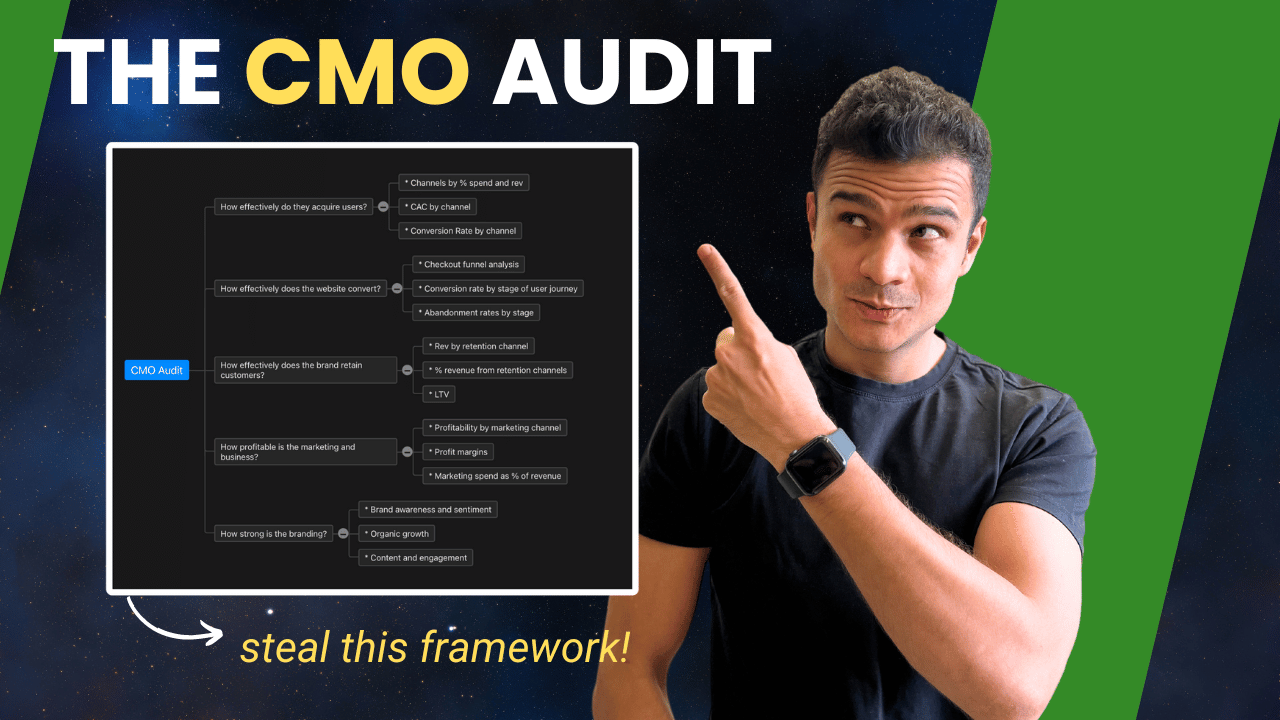As a consulting fractional CMO specializing in e-commerce D2C brands, I conduct thorough audits of their marketing strategies to ensure optimal growth.
Here’s a detailed breakdown of my audit process, structured into five essential categories, each with three critical metrics.
Table of Contents
1. User Acquisition Efficiency
Channel Diversification
Assessing how effectively a brand acquires users starts with examining the diversity of acquisition channels. It’s crucial not to be overly dependent on a single channel like Meta or Google Ads.
A well-diversified channel portfolio spreads risk and enhances stability. For instance, a channel split where 80% of the budget is spent on one channel indicates over-dependence and potential vulnerability. The goal is to distribute the budget more evenly across multiple channels while recognizing that some may perform better than others.
Cost of Acquisition by Channel (CAC)
Understanding the cost to acquire customers through each channel is vital. Comparing CAC with lifetime customer value or average order value helps determine the cost-effectiveness of each channel.
This metric provides insight into how affordable or expensive it is to acquire new customers, guiding budget allocation decisions.
Conversion Rate by Channel Analyzing the conversion rates across different channels highlights which ones are most effective. Some channels may have higher conversion rates but limited scalability, while others might scale better despite lower conversion rates.
This analysis helps identify where to focus efforts to optimize traffic and conversions.
2. Website Conversion Efficiency
Checkout Funnel Analysis
A detailed analysis of the checkout funnel involves examining each step of the user journey, from traffic to product pages, add-to-cart, initiated checkout, and completed checkout.
Breaking down these stages by user segments, personas, and acquisition channels provides a granular view of where potential customers drop off, helping to identify and fix conversion bottlenecks.
Conversion Rate Optimization (CRO)
Improving the website’s conversion rate is crucial. Even with effective acquisition channels, poor website conversion can result in lost sales.
By analyzing conversion rates at various stages and for different user cohorts, businesses can implement targeted improvements to enhance overall conversion.
3. Customer Retention Effectiveness
Revenue by Retention Channel
Evaluating the revenue generated from retention channels such as email, SMS, push notifications, and retargeting is essential. As businesses mature, a growing percentage of revenue should come from retention channels.
Initially, most revenue may come from new user acquisition, but over time, increasing revenue from retention channels indicates a healthy, loyal customer base.
Customer Lifetime Value (CLV) and Net Promoter Score (NPS)
Assessing metrics like CLV and NPS provides deeper insights into customer satisfaction and loyalty. These metrics help compare acquisition costs with the long-term value generated from customers, highlighting the profitability of retention efforts.
4. Marketing Profitability
Profitability by Channel
Analyzing the profitability of different marketing channels, including acquisition and retention channels, helps identify which channels offer the best return on investment. Understanding which channels are both scalable and profitable guides future budget allocations.
Profit Margins
Evaluating profit margins across various channels ensures that marketing efforts contribute positively to the overall profitability of the business. This metric is crucial for sustainable growth.
Marketing Spend as a Percentage of Total Revenue
Understanding the proportion of total revenue spent on marketing helps benchmark against industry standards and ensures that marketing spend is efficient and justified.
5. Brand Strength
Brand Awareness and Sentiment
Monitoring brand awareness and sentiment through social media listening, customer feedback, and direct customer interactions provides insights into how the brand is perceived. Both quantitative and qualitative methods are used to gauge customer sentiment.
Organic Growth
Tracking the growth of organic channels over time indicates the strength of the brand. A steady increase in organic traffic and conversions signifies successful brand-building efforts.
Content Engagement
Analyzing engagement with brand-related content, whether user-generated, influencer-driven, or created in-house, helps understand how well the brand resonates with its audience.
Watch the full video tutorial below:
Conclusion
This comprehensive audit process provides a holistic view of a brand’s marketing effectiveness.
Whether you are a business owner, a CMO, or a fractional CMO, this checklist helps identify strengths and areas for improvement, guiding strategic decisions to foster growth and profitability.
Thank you for taking the time to read through this process. All the best on your growth and marketing journey.
Connect with me on LinkedIn here or subscribe on YouTube here.
